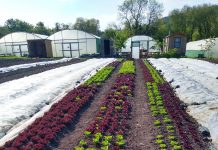May is a critical month for establishing so many crops, and if time is in short supply, don’t rush it, as early plantings need more work than when all is warm.
It is five years since we have had such a cold spring, and the peas, beans, beetroot and lettuce planted out in late March were all looking unhappy, even under fleece, until we had a splash of warmth mid-month.
Slugs? The EU have recently re-invented ancient folklore and called it Integrated Pest Management (IPM). Although their main drive is to try and reduce the amount of pesticides washing into our rivers, the useful message is to look at the bigger picture of soil and plant health, which naturally reduced pest numbers in the first place.
Limiting slug damage is all about keeping plants strong in healthy soil as well as reducing their numbers by denying them weeds to eat over the winter, and nurturing an ecosystem where there are plenty of slug predators, such as the hedgehogs we have in our garden.
Timing is important, too. Unless you have exceptionally green fingers, it is much easier to establish your crops when it is warm. Courgettes are a good example. Our healthy little plants will be transplanted into rich soil in early May, and fleeced over for a month. It is safer to transplant later in the month, but fleecing keeps them warm early on.
Establishing your runner and French bean is the ultimate test of warmth, see below—transplant late or you will have ‘has beans’. In the Spring Gap we are still eating Borlotti French (haricot) beans we grew last year, an excellent dual variety. And what is a Kardashibean? It’s a family of bean-shaped women.
What to sow this month
Most things!
Sow outdoors: carrots, parsnip, beetroot, leeks etc.
Transplant from greenhouse sowings: sweetcorn, courgettes, celery, autumn cauliflower, calabrese, summer cabbage, basil, etc. Late in the month, or even in June, cucumbers, tomatoes, runner and French beans.








